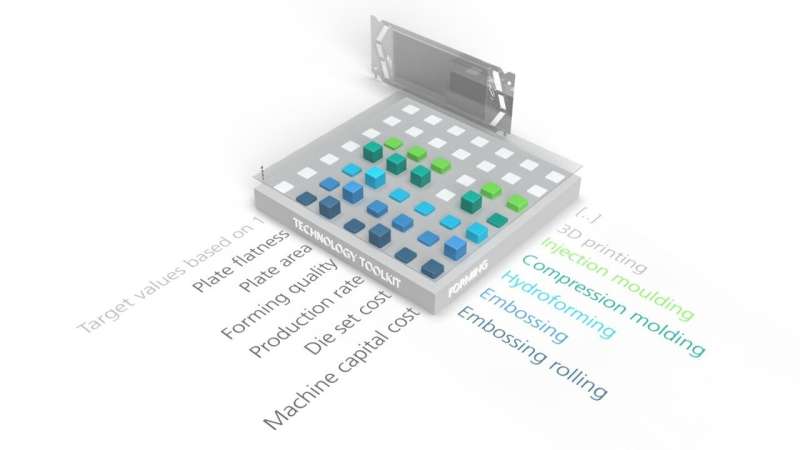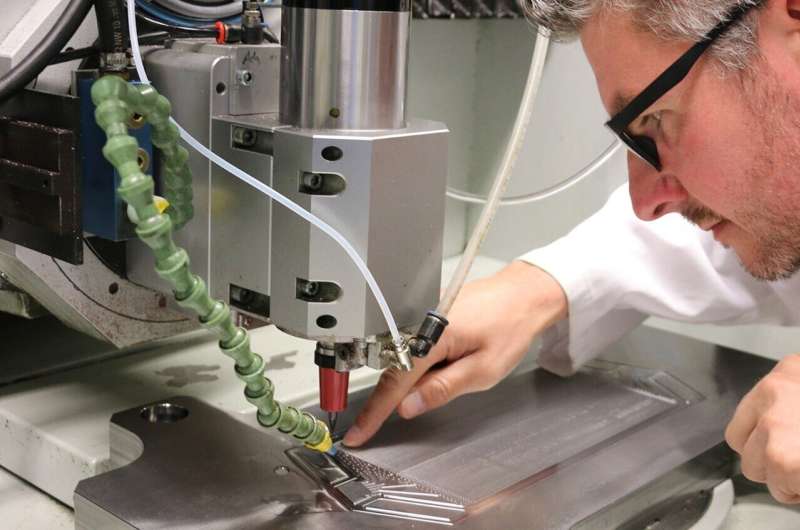Technology toolkit for bipolar plate production of fuel cells

Fuel cells have huge potential, but there are not yet any clear structures and standards surrounding their manufacture. The huge number of options when it comes to production technologies makes it challenging for users or potential users to maintain an overview in their mind and to select the right production process to suit their needs. To help overcome this problem, researchers at the Fraunhofer Institute for Machine Tools and Forming Technology IWU and the Fraunhofer Institute for Production Technology IPT are developing a virtual technology toolkit. This toolkit will help users to make the best production decisions when manufacturing fuel cells by enabling them to select the forming technology for bipolar plates that is most appropriate to the specific application.
The interest in and need for fuel cells are constantly growing. They represent a highly promising and more environmentally friendly alternative to fossil energy sources, an issue of particular relevance in the mobility sector. However, before they can be mass-produced, fuel cells must be made easier and more cost-effective to manufacture. In particular, there is great potential for cost reduction in the production of the bipolar plates. These are a central element of fuel cells and control the supply of hydrogen and air as well as the extraction of steam and energy. The design of the flow field, which reflects the channel structures of the bipolar plate, is particularly important here. The gases involved in the process flow through these channels. The larger the surface area and the flatter the plates, the better the bipolar plates can interact with the other components and the more efficient the fuel cell will be.
The shape of the bipolar plates and their flow field is created during the forming process. The experts at both the Fraunhofer Institute for Machine Tools and Forming Technology IWU in Chemnitz and the Fraunhofer Institute for Production Technology IPT in Aachen are particularly familiar with this step in the production process. This is why they have decided to distill their expertise into a shared virtual technology toolkit.
Decision-making tools for technology and materials
"The companies that reach out to us are usually looking to invest in the production of fuel cells. They have some basic ideas about what the forming process will involve but are not sure what the economic consequences of using this process will be. For example, production rates and manufacturing costs are particularly difficult to assess," explains Dr. Ulrike Beyer, Head of the TaskForce Hydrogen@IWU. "Using our technology toolkit, we can apply evidence-based analyses to observe the initial situation, taking in all the possible outcomes, and consider the various dependencies systematically. This allows us to develop a tailor-made technological solution for any needs."

In addition to machine capital, die set costs and the production quantity, the parameters which the researchers factor into the decision include the forming results that can be achieved, such as size, flatness and flow field design. Hydroforming, embossing, embossing rolling, compression molding—the individual focus changes which of the available forming processes is the most promising, as Beyer says: "For example, while embossing and hydroforming are able to produce bipolar plates of high quality, up to now only embossing rolling has been able to achieve a significant increase in the production rate. However, embossing rolling has its own disadvantages in other areas."
The raw material used also influences the choice of forming process, as Dr. Christoph Baum, Managing Director of Fraunhofer IPT, has experienced: "Originally, we mainly worked with composite materials. These ensure that the fuel cells have a long service life, but they only have limited suitability for mass production because they require more effort and are more expensive to produce. In addition, with composite materials, the material thickness remains rather high, even after processing. This means any fuel cell stack quickly becomes very large, which makes them impractical for use in vehicles. This has led to us increasingly using materials like steel, usually achieving better and more cost-effective results." In addition, the order of the production steps can be varied based on the technology selected. This means, for example, that the bipolar plates should be coated before or after forming depending on the intended application. The technology toolkit can provide guidance here as well.
Objective: technology toolkit for the entire fuel cell production process
The Fraunhofer Institute for Manufacturing Engineering and Automation IPA is currently developing a website for the technology toolkit, which will be available shortly. However, tailored consultation on implementing the ideal forming process is already available.
In the medium term there are plans to expand the technology toolkit to include additional production steps and fuel cell components in cooperation with other Fraunhofer Institutes. "Our goal is to create a large overarching digital platform that allows individual production steps to be viewed and combined with each other in order to find the optimal combination for producing a complete fuel cell for a specific situation," says Beyer. This will be made possible through the National Action Plan for Fuel Cell Production of the Fraunhofer-Gesellschaft, which is currently being designed.
















